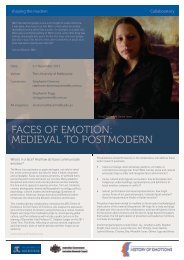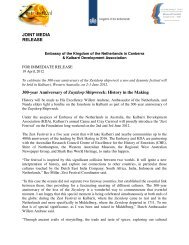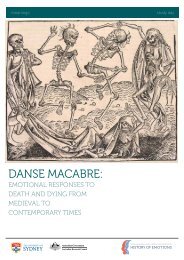Download our K-12 education pack - ARC Centre of Excellence for ...
Download our K-12 education pack - ARC Centre of Excellence for ...
Download our K-12 education pack - ARC Centre of Excellence for ...
Create successful ePaper yourself
Turn your PDF publications into a flip-book with our unique Google optimized e-Paper software.
stories <strong>for</strong> teachers & students 2013<br />
The Geography <strong>of</strong> (European)<br />
Emotions: Good Hope and<br />
Good Health<br />
Supporting Res<strong>our</strong>ces<br />
South Africa, Far from Home<br />
stories by winthrop pr<strong>of</strong>essor susan broomhall<br />
On either side <strong>of</strong> the equator lies an area known as the<br />
Intertropical Convergence Zone (ICTZ), or more commonly as the<br />
doldrums. Here, low pressure and solar heating <strong>for</strong>ces air to rise<br />
and cause immense rain, making the area one <strong>of</strong> the wettest in<br />
the world. With the air rising upwards rather than horizontally, the<br />
area has made tough work <strong>for</strong> sailors trying to catch the wind in<br />
the sails. In the age <strong>of</strong> sails, all they could do was wait, hope and<br />
pray <strong>for</strong> fav<strong>our</strong>able winds to continue on their j<strong>our</strong>ney. On the<br />
voyage that brought Dirk Hartog to Australian shores, <strong>for</strong> example,<br />
Hartog lost six weeks in the Gulf <strong>of</strong> Guinea near Cape Lopez.<br />
Adding to the distress, currents in the water could move vessels<br />
considerably <strong>of</strong>f c<strong>our</strong>se so that when the winds did pick up, they<br />
had even further to go to reach their destinations.<br />
It’s hard to say whether this experience caused the dull, listless<br />
and depressed mood that we now associate with that term, or<br />
was the reason that the area has long held this name amongst<br />
mariners.<br />
Whichever is the case, the doldrums was a feared part <strong>of</strong> the<br />
passage to and from South Africa. During these delays in passing<br />
through this area, crews used up their supplies <strong>of</strong> fruit and<br />
vegetables and began to lose many aboard to illness. On board,<br />
scurvy resulted in many deaths. When the Zuytdorp arrived in the<br />
Cape in April 17<strong>12</strong>, it had lost 1<strong>12</strong> <strong>of</strong> its 286 crew in the sevenmonth<br />
j<strong>our</strong>ney from Wielingen. This was quite a remarkable loss,<br />
some two-fifths <strong>of</strong> the crew. Arent Blankert, master surgeon <strong>of</strong><br />
the Unie which was in Table Bay at the same time recorded the<br />
Zuytdorp’s arrival and deaths ‘by scurvy, hot diseases, and raging<br />
fevers. The chief-surgeon and both his mates had jumped<br />
overboard in their delirium and ragings, notwithstanding all<br />
conceivable precautions.’ By the time they arrived at the Cape,<br />
crews were in severe need <strong>of</strong> fresh food and water. The Vergulde<br />
Draeck’s provisions loaded in Cape Town included 7 cows, 10<br />
sheep and cabbages, carrots, radishes, melons and<br />
watermelons, as well as ‘good, fresh, healthy people’.<br />
The Dutch were not the first to see the value in the Cape area as<br />
a place to stop and restock their ships. It was a Portuguese<br />
explorer, Bartholomeu Dias, who two centuries earlier first<br />
recorded rounding the Cape in 1488. Dias was guided by texts<br />
and maps from ancient times, especially Ptolemy’s Geography.<br />
This told <strong>of</strong> another passage around the African continent, to<br />
Asia. At that time, the Portuguese were seeking a passage<br />
around Africa by which they could reach the Indies and Far East<br />
where they believed vast riches were to be found. This would<br />
mean they could avoid travelling overland through the Middle<br />
East. Two previous voyages by Diogo Cão had preceded Dias,<br />
each snaking their way further down Africa’s west coast. Dias<br />
however made it to the very bottom <strong>of</strong> the continent. He went as<br />
far around Southern Africa as Kwaaihoek. At this point, his crew<br />
became afraid and begged him to turn back now that they had<br />
discovered enough to show that there was a way around. Dias<br />
was <strong>for</strong>ced to give in to their fears. On his way back west, he<br />
discovered the Cape itself, which he named the ‘Cabo das<br />
Tormentas’ (Cape <strong>of</strong> Storms), from the rough winds and seas he<br />
experienced in the area.<br />
King John II <strong>of</strong> Portugal gave the Cape the name Good Hope by<br />
which we know it today, enc<strong>our</strong>aged by the possibilities <strong>of</strong><br />
establishing a global trading empire. Duarte Pacheco Pereira,<br />
writing in his 1508 Esmeraldo de Situ Orbis, wrote that ‘the coast<br />
here turns northwards and northeastwards … giving great hope<br />
<strong>of</strong> the discovery <strong>of</strong> India.’ In this endeav<strong>our</strong>, the Cape was a<br />
halfway point. By the time sailors reached the Cape, they could<br />
have good hope <strong>of</strong> reaching their destinations – whether back<br />
home to Portugal, or onwards to the Indies. In his 1552<br />
publication, Décedas da Asia, João de Barros celebrated ‘that<br />
great and notable Cape, hidden <strong>for</strong> so many hundreds <strong>of</strong> years<br />
and which when it is seen, not only reveals itself, but opens up an<br />
entire new world <strong>of</strong> countries.’ Hope was in the air.<br />
It was a name that the Dutch maintained, and one that tells us<br />
much about European hopes and dreams about their voyages to<br />
the southern oceans.<br />
FAR FROM HOME: ADVENTURES, TREKS, EXILES & MIGRATION<br />
29












